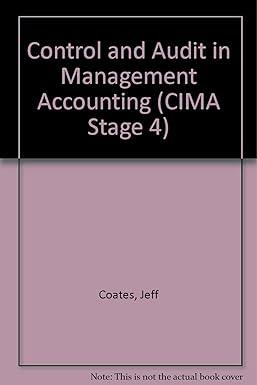Question
Lambert, Inc. is a manufacturer of men's casual clothing. The founder and CEO of the company retired on June 30, Year 1, after 10 years
Lambert, Inc. is a manufacturer of men's casual clothing. The founder and CEO of the company retired on June 30, Year 1, after 10 years of management. During this time, sales and net profits increased modestly, but the CEO was very conservative about taking credit risk. On July 1, Year 1, Lambert hired a new CEO with a strong marketing background. The company adopted a new business plan, which includes aggressive expansion into new markets and liberalization of the companys credit policy. This new business plan was implemented in the fourth quarter of Year 1, and resulted in a significant increase in sales for the month of December. Lambert uses the allowance method to record doubtful accounts for financial statement reporting. In prior years, Lambert estimated its uncollectible accounts receivable by applying an estimated percentage to each category reported on the accounts receivable aging analysis. This percentage is based on historical data. The following table summarizes the accounts receivable aging analysis at December 31, Year 1, and the related estimated percentage uncollectible for each category.
| Accounts Receivable Aging Analysis at December 31, Year 1 | ||
| Aging Category | Balance | Estimated Percentage Uncollectible |
| 0 - 30 days | $225,000 | 1% |
| 31 - 60 days | $240,000 | 9% |
| 61 - 90 days | $127,000 | 23% |
| over 90 days | $85,000 | 60% |
The balance in the allowance for doubtful accounts at January 1, Year 1, was $62,000. The activity in this account during Year 1 consisted of the write-off of accounts valued at $19,000 and a recovery of $4,000 in accounts that were written off in previous years. The Lambert accounting staff identified the following unrecorded adjustments while performing the year-end review of accounts receivable balances:
| An account receivable for $12,000 that was invoiced in February, Year 1 was deemed uncollectible because the customer was declared bankrupt on November 30, Year 1. The balance has not yet been written off. | |
| An account receivable for $5,000 that was invoiced in August, Year 1 was collected. However, it was not properly removed from the accounts receivable subsidiary ledger and the aging analysis. |
As a result of the change in the Lambert credit policy during Year 1, the CFO believes that the estimated percentage uncollectible for each aging category should be increased by two percentage points.
QUESTION
Complete the following spreadsheet to calculate the allowance for doubtful at December 31, Year 1, for each shaded cell in column C, D, E, and F.enter the appropriate values. The totals in column B will calculate automatically based on your entries. If there is nothing to enter in a particular cell.
| A | B | C | D | E | F |
|
| TOTAL | 0 30DAYS | 31-60DAYS | 61-90DAYS | OVER 90 DAYS |
| ACCOUNTS RECIEVABLE |
|
|
|
|
|
| ADJUSTMENTS |
|
|
|
|
|
| ADJUSTED ACCOUNTS RECEIVABLE |
|
|
|
|
|
| ESTIMATED PERCENTAGE UNCOLLECTIBLE |
|
|
|
|
|
| ALLOWANCE FOR DOUBTFUL ACCOUNT |
|
|
|
|
|
|
|
|
|
|
|
|
Step by Step Solution
There are 3 Steps involved in it
Step: 1

Get Instant Access to Expert-Tailored Solutions
See step-by-step solutions with expert insights and AI powered tools for academic success
Step: 2

Step: 3

Ace Your Homework with AI
Get the answers you need in no time with our AI-driven, step-by-step assistance
Get Started


